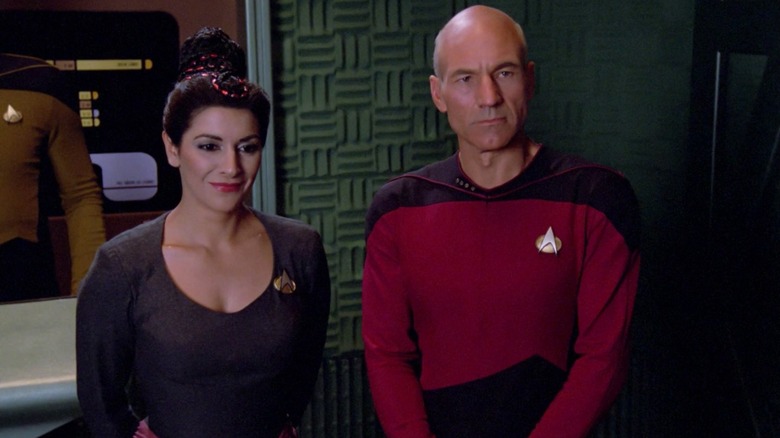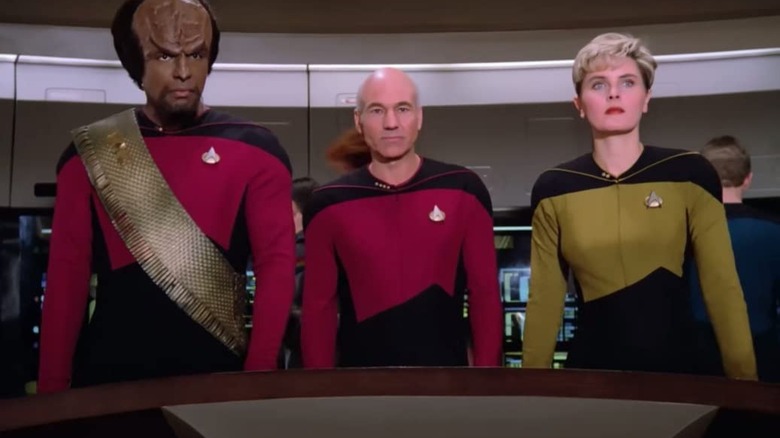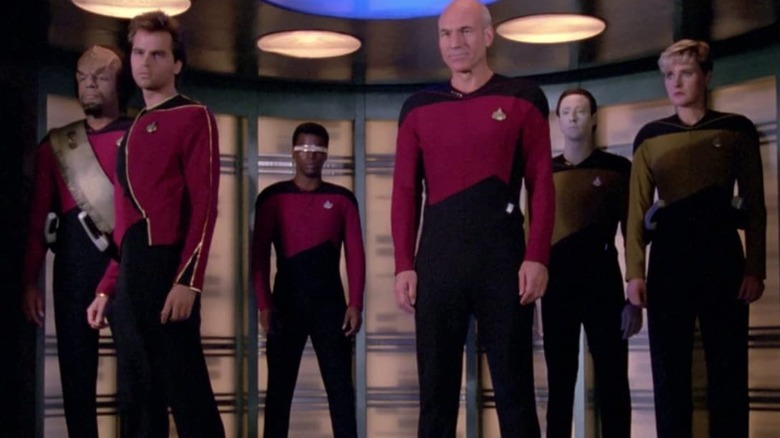The Most Uncomfortable Uniforms In The Universe Led To An Iconic Star Trek Maneuver
If one was in a critical mood, one might point out that many of the Starfleet uniforms seen throughout "Star Trek" don't really scream professionalism. In the original series, futuristic military uniforms were little more than warm, tight-fitting t-shirts, black slacks, and polished black boots. Women, meanwhile, wore tailored minidresses and black leggings, hardly practical for away missions that may involve hiking, phaser fire, or quick movement. One might need to flex their well-toned headcanon muscles to posit that future fabrics were more durable and regulated temperature better than what we have here in the 21st century.
On "Star Trek: The Next Generation," things didn't improve much. For one, some of the original minidresses remained in the backgrounds of the show's first few episodes. This was in the decidedly post-minidress year of 1987. To be fair, the showrunners clearly tried taking the curse off of the inherently sexist costuming by putting a few men in minidresses as well. Exposed legs were soon abandoned altogether, however. For the most part, Starfleet officers wore one-piece, long-sleeve jumpsuits that didn't allow for a lot of natural movement and, uh, weren't very flattering. As actor Jonathan Frakes said in Larry Nemecek's "The Star Trek: The Next Generation Companion," if you had an extra donut that morning, everyone could see it.
In his new autobiography "Making It So: A Memoir," Patrick Stewart also proclaimed his distaste for the uniforms, saying that they were ill-cut, clingy, and perhaps a little too reminiscent of show creator Gene Roddenberry's 1960s notions that everyone would wear sexy, skin-tight clothing in the future. Stewart said that he petitioned for a costume change that was eventually implemented ... in the show's third season.
Season one uniforms
In the third season of "Star Trek: The Next Generation," the uniforms were altered into something that looked more comfortable and more professional. The top portion of the uniform was a roomier tunic and wasn't entirely attached to the pants. The costume designer also added small collars where the characters' rank pips would be placed. Up until then, the actors were stuck in their clingy, sexist jumpsuits. Patrick Stewart was not shy about his opinions of the uniforms, saying:
"Gene, it is well known, was a fan of cheesecake — he had Marina [Sirtis] wear a minidress and go-go boots in the pilot, as if the 1960s had never ended, and had contemplated giving Deanna Troi three or even four breasts. We all suffered to a degree from a directive to look sexy. Our one-piece uniforms, created by the original Star Trek's costume designer, William Ware Theiss, were made of spandex and deliberately cut one size too small so that they never wrinkled and kept our bodies on constant display."
The uniforms certainly fulfilled that mandate, but they didn't feel great. Indeed, Stewart said that wearing the unforms actually hurt, writing:
"The problem was that these uniforms, beyond their leaving little to the imagination, were constricting to the point of causing pain. When I stood up straight — a requirement of the role — my one-piece stretched tightly across my chest, thighs, and back, which caused all sorts of aches."
Stewart eventually devised a plan to get out of those uniforms. He wrote that he asked his doctor to petition the producers, claiming that he couldn't wear the tight outfit for medical reasons. If they didn't change the uniforms, Stewart would sue the studio for the cost of his medical bills.
It worked.
It must remain smooth
Of course, when the uniforms were finally altered, the mandate to keep them smooth-looking didn't go away. There was to be no wrinkling, no bunching. This caused Patrick Stewart to develop a physical mannerism that all Trekkies will instantly recognize. Named after an in-universe starship battle tactic, Stewart's slight tug on his uniform to straighten it out every time he sat down or stood up was soon called the Picard Maneuver. Stewart wrote:
"It took a couple of seasons to implement the changes, but finally, a new costume designer, Robert Blackman, sympathetically came up with a two-piece uniform made of polyester. My new getup, with a top separate from my trousers, was still snug, but it had plenty of give. Gene, however, was adamant that Captain Picard's uniform must always be unfailingly smooth. So every time I sat down in my captain's chair, I tugged on the hem of my tunic — a tic that 'Star Trek' fans have named the 'Picard maneuver.'"
So even though the uniforms had been altered to be more comfortable and aesthetically pleasing, Stewart still had to keep his clothing unwrinkled. I guess wrinkles are a 20th-century problem. And Stewart was hardly the only one to perform this maneuver. Trekkies might recall seeing multiple cast members having to adjust their uniforms constantly.
The more recent "Star Trek" uniforms were eventually replaced by a pajama-like outfit with a soft, grey, cotton collar that extended up from a seeming long john-like undergarment. Well, when they weren't corsets. In recent years, there have been a slew of new uniforms across multiple series. Few of them have managed to look properly professional or military-grade. At the very least, the newer uniforms look much more comfortable than spandex jumpsuits.


